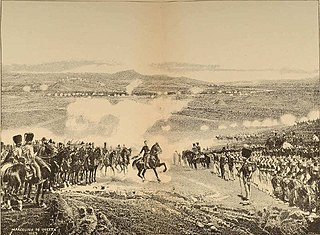
The First Carlist War was a civil war in Spain from 1833 to 1840, the first of three Carlist Wars. It was fought between two factions over the succession to the throne and the nature of the Spanish monarchy: The conservative and devolutionist supporters of the late king's brother, Carlos de Borbón, became known as Carlists (carlistas), while the progressive and centralist supporters of the regent, Maria Christina, acting for Isabella II of Spain, were called Liberals (liberales), cristinos or isabelinos. It is considered by some authors to be the largest and most deadly civil war of the period.

Anoeta is a town located in the province of Gipuzkoa, in the autonomous community of Basque Country, in the north of Spain.
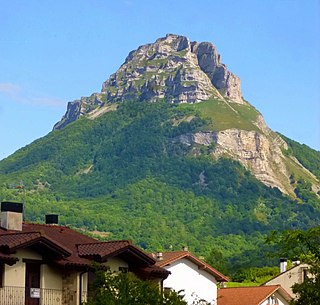
Arbizu is a village and municipality in the province and autonomous community of Navarre, northern Spain, neighbouring Etxarri-Aranatz. Its traditional "fiesta" falls on June 24, St. John's day, and is noted for the feast held in the main square.

Villabuena de Álava in Spanish or Eskuernaga in Basque is a municipality located in the province of Álava, in the Basque Country of northern Spain. It is famous for its production of top quality wines. The village has 48 wineries ranging from small family-owned businesses to larger bulk-production wineries. The centre of the village contains one of the oldest and most decorated churches in the Basque region, the Nearby is Hotel Viura, a boutique hotel.

Echarri is a town and municipality located in the province and autonomous community of Navarre, northern Spain.

Estella (Spanish) or Lizarra (Basque) is a town located in the autonomous community of Navarre, in northern Spain. It lies south west of Pamplona, close to the border with La Rioja and Álava.
Sesma is a town and municipality located in the province and autonomous community of Navarre, northern Spain. It was the scene of action between Liberals under Narciso Lopez, and Carlists under Mendiry, during the First Carlist War, on 5th. November 1834 following the Carlist victory at Vitoria.

Zúñiga is a town and municipality located in the province and autonomous community of Navarre, northern Spain.
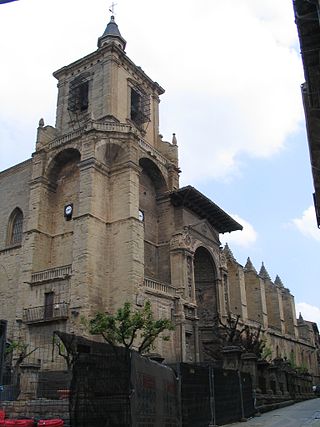
Viana is a town and municipality located in the province and autonomous community of Navarre, northern Spain. Cesare Borgia is buried there.
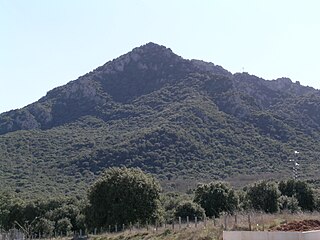
The Montejurra incidents, was a neo-fascist terrorist attack that took place on May 9, 1976, when two Carlist members were killed and another three seriously wounded by right-wing gunmen at the annual Carlist Party celebration that was held in Montejurra, Navarre, Spain.
WKEG is a non-commercial Catholic radio station in Sterling Heights, Michigan. The station broadcasts with 5,000 watts, daytime only, with coverage of the Detroit metropolitan area. WKEG is a Class D station operating on the clear-channel frequency of 1030 AM; WBZ in Boston is the dominant Class A station on this frequency.

The Fort Alfonso XII or San Cristóbal is a fort located on the top of the mount San Cristóbal or Ezcaba, 4 km from Pamplona, Spain. It was erected following the 1872-1876 Carlist War to control a strategic point towering over Pamplona. It was later made into a makeshift prison during the 2nd Spanish Republic, bearing witness during Civil War to a halfhearted massive prison break by leftist prisoners that ended up with the death of hundreds.

The Battle of Arlabán, a battle of the First Carlist War, occurred at the heights of Arlabán, between the provinces of Álava and Guipúzcoa. Between 16 and 17 January 1836, the Liberals occupied Arlaban after dislodging the Carlist forces there. The Liberals were commanded by Luis Fernández de Córdova and were supported by the British Legion, French Legion, and units commanded by Baldomero Espartero; the forces were divided along three fronts. After conquering Arlabán as well as Legutiano, however, the Liberals were pushed back by the Carlists on 18 January, suffering a large number of casualties.
The Battle of Alsasua, also known as the Battle of Altsasu or la Acción de la Venta de Alsasua, occurred on April 22, 1834 in Navarre, Spain, during the First Carlist War. Carlist general Tomás de Zumalacárregui attacked a convoy led by the Liberal general Vicente Genaro de Quesada traveling from Vitoria-Gasteiz to Pamplona at the town of Alsasua.
The Second Battle of Arquijas was a battle of the First Carlist War. It followed the First Battle of Arquijas. The battle was a second attack on the positions of Carlist commander Tomás de Zumalacárregui at the pass at Arquijas, Navarre.
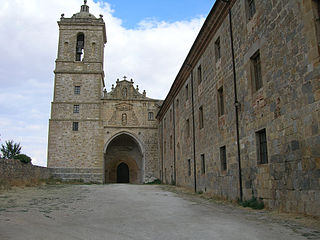
Santa María la Real de Irache is a former Benedictine monastery located in the town of Ayegui, Navarre, Spain. It dates from the eighth century, although the surviving buildings are later.

The Nationalist faction or Rebel faction was a major faction in the Spanish Civil War of 1936 to 1939. It was composed of a variety of right-leaning political groups that supported the Spanish Coup of July 1936 against the Second Spanish Republic and Republican faction and sought to depose Manuel Azaña, including the Falange, the CEDA, and two rival monarchist claimants: the Alfonsist Renovación Española and the Carlist Traditionalist Communion. In 1937, all the groups were merged into the FET y de las JONS. After the death of the faction's early leaders, General Francisco Franco, one of the members of the 1936 coup, headed the Nationalists throughout most of the war, and emerged as the dictator of Spain until his death in 1975.

Eskibel is a village in Álava, Basque Country, Spain. It forms part of the Southwest Rural Zone of Vitoria. It is situated 7.5 km southwest of the city in a small valley surrounded by the Mountains of Vitoria.
Dustin is an unincorporated community in Holt County, Nebraska, United States.

Navarrese nationalism is a political and social movement that claims Navarre to be a nation.















